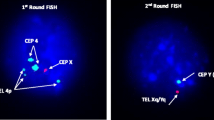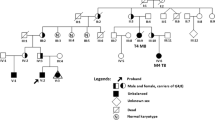Summary
Cytogenetic and molecular genetic findings in 91 patients with Turner syndrome are reported. In 87 patients, chromosome studies were carried out both in lymphocyte and fibroblast cultures. Mosaicism was demonstrated in 58 of these patients (66.7%), whereas only 18 (20.7%) were apparent non-mosaic 45,X, and 11 patients (12.6%) showed non-mosaic structural aberrations of the X chromosome. Among the mosaic cases 16 (18.4% of all patients) displayed a second cell line containing small marker chromosomes. The association of Y-specific chromosomal material with the presence of marker chromosomes was demonstrated in 6 out of 7 mixoploid fibroblast cell lines by polymerase chain reaction amplification and by Southern-blot analysis. The observation of ring formation and morphological variability in vivo and in vitro, and the continous reduction in the percentage of cells containing marker chromosomes in longterm cultivation experiments indicated an increased instability of marker chromosomes. The findings suggest that in vivo selection of structurally altered sex chromosomes exists. Thus, the observation of apparent non-mosaic 45,X chromosomal complements in liveborn individuals with Turner syndrome does not contradict the hypothesis that some degree of mosaicism is necessary for survival in early pregnancy.
Similar content being viewed by others
References
Arnemann J, Epplen JT, Cooke HJ, Sauermann U, Engel W, Schmidtke J (1987) A human Y-chromosome DNA sequence expressed in testicular tissue. Nucleic Acids Res 15:8713–8724
Ashworth A, Rastan S, Lovell-Badge R, Kay G (1991) X-chromosome inactivation may explain the difference in viability of XO humans and mice. Nature 351:406–408
Barlow PW (1972) Differential cell division in human X chromosome mosaics. Hum Genet 14:122–127
Caspersson T, Zech L, Johansson C (1970) Analysis of human metaphase chromosome set by aid of DNA-binding fluorescent agents. Exp Cell Res 62:490–492
Chapelle A de la (1983) Sex chromosome abnormalities. In: Emery AEH, Rimoin DL (eds) Principles and practice of medical genetics. Churchill Livingstone, Edinburgh, pp 193–215
Connor JM, Loughlin SAR (1989) Molecular genetics of Turner's syndrome. Acta Paediatr Scand 356:77–80
Cooke HJ, Schmidtke J, Gosden JR (1982) Characterisation of a human Y chromosome repeated sequence and related sequences in higher primates. Chromosoma 87:491–502
Fisher EMC, Beer-Romero P, Brown LG, Ridley A, McNeil JA, Lawrence JB, Willard HF, Bieber FR, Page DC (1990) Homologous ribosomal protein genes on the human X and Y chromosome: escape from X inactivation and possible implications for Turner syndrome. Cell 63:1205–1218
Gemmill RM, Pearce-Birge L, Bixenman H, Hecht BK, Allanson JE (1987) Y chromosome-specific DNA sequences in Turner syndrome mosaicism. Am J Hum Genet 41:157–167
Hall JG, Sybert VP, Williamson RA, Fisher NL, Reed SD (1982) Turner's Syndrome. West J Med 137:32–44
Hassold T, Kumlin E, Takaesu N, Leppert M (1985) Determination of the parental origin of sex-chromosome monosomy using restriction fragment length polymorphisms. Am J Hum Genet 37:965–972
Hassold T, Benham F, Leppert M (1988) Cytogenetic and molecular analysis of sex-chromosome monsomy. Am J Hum Genet 42:534–541
Held KR, Sönnichsen S (1984) The effect of oxygen tension on colony formation and cell proliferation of amniotic fluid cells in vitro. Prenat Diagn 4:171–179
Hoehn H, Simpson M, Bryant EM, Rabinovitch PS, Salk D, Martin GM (1980) Effects of chromosome constitution on growth and longevity of human skin fibroblast cultures. Am J Med Genet 7:141–154
Hook EB (1977) Exclusion of chromosomal mosaicism: tables of 90%, 95%, and 99% confidence limits and comments on use. Am J Hum Genet 29:94–97
Hook EB, Warburton D (1983) The distribution of chromosomal genotypes associated with Turner's syndrome: livebirth prevalence and evidence for diminished fetal mortality and severtiy in genotypes associated with structural X abnormalities or mosaicism. Hum Genet 64:24–27
Jacobs PA, Betts PR, Cockwell AE, Crolla JA, Mackenzie MJ, Robinson DO, Youings SA (1990) A cytogenetic and molecular reappraisal of a series of patients with Turner's syndrome. Ann Hum Genet 54:209–223
Jakubiczka S, Arnemann J, Kahler S, Thüring S, Schmidtke J (1990) A rapid protocol for the characterization of Yp aberration. 2. Tagung der Gesellschaft für Humangenetik, Bonn, March 1990
Johnson VP, McDonough PG, Cheung SW, Sun L (1991) Sex chromosome marker: clinical significance and DNA characterization. Am J Med Genet 39:97–101
Kalousek DK, Dill FJ, Pantzar T, McGillivray BC (1987) Confined chromosomal mosaicism in prenatal diagnosis. Hum Genet 77:163–167
Kaminsky E, Singh S, Held KR, Kerber S, Seemanova E, Goedde HW (1991) Risk assessment for gonadal tumours in patients with Turner syndrome and its mosaics by identification of Y chromosome-specific sequences. In: Issinger OG (ed) Advances in molecular genetics 3. Hüthig, Heidelberg, pp 193–207
Kukharenko VI, Grinberg KN, Kuliev AM (1978) Mitotic cycles in human cell strains with sex chromosomes aneuploidy. Hum Genet 42:157–162
Lin CC, Meyne J, Sasi R, Bowen P, Unger T, Tainaka T, Hadro TA, Hoo JJ (1990) Determining the origins and the structural aberrations of small marker chromosomes in two cases of 45,X/46,X,+mar by use of chromosome-specific DNA probes. Am J Med Genet 37:71–78
Magenis E, Donlon T (1982) Nonfluorescent Y chromosomes. Cytologic evidence of origin. Hum Genet 60:133–138
Nagel T, Camargo M, Tagatz G, Okagaki T, Cervenka J, Cahill L, Wachtel S, King R, Twiggs LB (1984) Gonadal tumors in patients with gonadal dysgenesis and sex chromosomal rings and fragments. Am J Obstet Gynecol 150:76–82
Page DC, Mosher R, Simpson EM, Fisher E, Mardon G, Pollack J, McGillivray B, Chapelle A de la, Brown LG (1987) The sex-determining region of the human Y chromosome encodes a finger protein. Cell 51:1091–1104
Pai GS, Thomas GH (1980) A new R-banding technique in clinical cytogenetics. Hum Genet 54:41–45
Palmer CG, Reichmann A (1976) Chromosomal and clinical findings in 110 females with Turner syndrome. Hum Genet 35:35–49
Park E, Bailey JD, Cowell CA (1983) Growth and maturation of patients with Turner's syndrome. Pediatr Res 17:1–7
Polani PE (1970) Growing points in cell pathology. Proc R Soc Med 63:955–959
Procter SE, Watt JL, Lloyd DJ, Duffty P (1984) Problems of deecting mosaicism in skin. A case of trisomy 8 mosaicism illustrating the advantages of in situ tissue culture. Clin Genet 25:273–277
Ranke MB, Pflüger H, Rosendahl W, Stubbe P, Enders H, Bierich JR, Majewski F (1983) Turner syndrome: spontaneous growth in 150 cases and review of the literature. Eur J Pediatr 141:81–88
Saiki RK, Scharf F, Faloona S, Mullis K, Horn G, Erlich H, Arnheim N (1985) Enzymatic amplification of β-globin genomic sequences and restriction site analysis for diagnosis of sickle-cell anemia. Science 230:1350–1354
Scherer G, Schempp W, Baccichetti C, Lenzini E, Dagna Bricarelli F, Carbone LD, Wolf U (1989) Duplication of an Xp segment that includes the ZFX locus causes sex inversion in man. Hum Genet 81:291–294
Seabright M (1971) A rapid banding technique for human chromosomes. Lancet II:971–972
Sumner AT (1972) A simple technique for demonstrating centromeric heterochromatin. Exp Cell Res 75:304–306
Verp MS, Rosinsky B, LeBeau MM, Martin AO, Kaplan R, Wallemark CB, Otano L, Simpson JL (1988) Growth disadvantage of 45,X and 46,X,del(X)(p11) fibroblasts. Clin Genet 33:277–285
Waye JS, Willard HF (1988) Chromosome-specific α satellite DNA: nucleotide sequences of the 2. 0kb repeat from the human X chromosome. Nucleic Acids Res 13:2731–2743
Witt M, Erickson RP (1989) A rapid method for detection of Y chromosomal DNA from dried blood specimens by the polymerase chain reaction. Hum Genet 82:271–274
Witt M, Erickson RP (1991) A rapid method for detection of Y-chromosomal DNA from dried blood specimens by the polymerase chain reaction (Erratum). Hum Genet 86:540
Wolfe J, Darling SM, Erickson RP, Craig IW, Buckle VJ, Rigby P, Willard HF, Goodfellow PN (1985) Isolation and characterization of an alphoid centromeric repeat family from human Y chromosome. Mol Biol 182:477–485
Wong C, Kazazian HH Jr, Stellen G, Earnshaw WC, VanKeuren ML, Antonarakis SE (1989) Molecular mechanism in the formation of a human ring chromosome 21. Proc Natl Acad Sci USA 86:1914–1918
Author information
Authors and Affiliations
Rights and permissions
About this article
Cite this article
Held, K.R., Kerber, S., Kaminsky, E. et al. Mosaicism in 45,X Turner syndrome: does survival in early pregnancy depend on the presence of two sex chromosomes?. Hum Genet 88, 288–294 (1992). https://doi.org/10.1007/BF00197261
Received:
Revised:
Issue Date:
DOI: https://doi.org/10.1007/BF00197261




